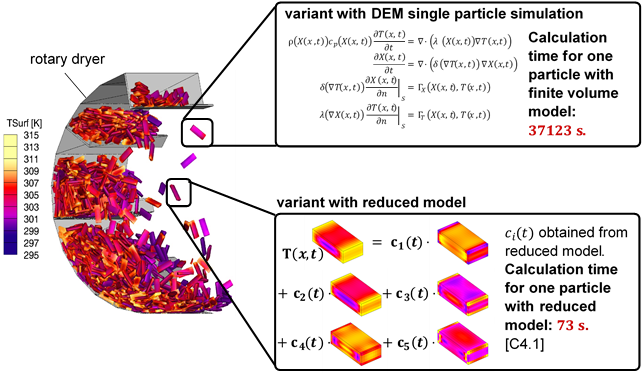C4
Model reduction of single particle models for coupled DEM/CFD simulations
Principal Investigator
Doctoral candidate
Associate doctoral candidate

Coupled DEM/CFD methods have proven to be powerful tools, but they are computationally expensive. A reduction of the computational effort is crucial for two of the long-term goals of the CRC/TRR: (1) Establishing DEM/CFD methods as a design tool for industrial processes and (2) permitting the simulation of even more complex processes than today, which are yet intractable due to a too high computational expense.
It is the goal of C4 to develop model reduction methods that permit simulating single particles with a fraction of the computational effort required by the DEM methods used today (see figure for results that demonstrate a reduction by a factor of 500). C4 does not develop new models or solvers for this purpose, but C4 reduces models of high spatial and temporal resolution developed in other projects of the CRC/TRR (B4, later A4) to low-dimensional models that provide the same resolution at a fraction of the computational cost. This step requires both tailoring of existing reduction methods for the reaction-convection-diffusion process models of the CRC/TRR, and developing entirely new reduction methods that deal with model families. Here the term “model families” refers to models for particles that are governed by the same reaction-convection-diffusion equations, but are subject to varying parameters (such as variable mass diffusivities, thermal conductivities), varying initial and boundary conditions (such as variable initial temperature distributions or heat fluxes that are a function of the location in a bulk of particles). Because it is not feasible to derive a reduced model for each particle with its particular parameters and conditions in a bulk, systematic methods for the reduction of model families are required that allow varying parameters of the type described above in the reduced model without repeating the model reduction procedure whenever these parameters change.

Besides reduced inner particle models, C4 aims to develop reduced-order models for the fluid region surrounding particles in packed-bed configurations. The high computational cost of the direct numerical simulations performed in CRC/TRR necessitates building reduced-order models that enable analysis of packed-bed configuration across a broad spectrum of initial and boundary conditions, such as inlet velocity and temperature of particles. By leveraging reduced-order modeling of the fluid phase, C4 aims to obtain an efficient representation of the boundary layer around the particles (see the animation for a comparison between the high-fidelity model and the reduced-order model results obtained at a fraction of the computational cost). The reduced model of the boundary layer should directly deliver heat and mass transfer dynamics between particles and fluid in packed-bed configurations. This advancement contributes to the efficient design and optimization of bulk reactors in various applications.



